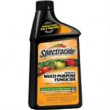






Fungicides are chemical compounds that are used to kill or inhibit fungi or fungal spores. Fungi can cause serious damage to your houseplants. The following plant diseases are the result of fungal infections: black spotHow to identify and treat Black Spot Disease, a houseplant disease caused by a fungal infection., botrytisBotrytis, or Gray Mold as it is commonly called, is a fungus that attacks the leaves, flowers, stems, and rhizomes of house plants. It first appears as a round brown or gray spot that gradually turns into a mass of fuzzy gray spores. This is where the nickname, Gray Mold, comes from. Prevent Botrytis by quickly removing all dead or dying leaves and flowers that can serve as a breeding grounds. Keep water off of the leaves and provide good air circulation around plants. If a plant becomes infected with Gray Mold, trim off the diseased areas, remove any soil that has mold on it, and spray with a commercial fungicide. If you are adverse to chemicals you can try this homemade remedy. Put a tablespoon or two of baking soda in a spray bottle, add a teaspoon or two of mineral oil, and fill with water. Shake well and spray all parts of the plant. Botrytis often attacks the flower buds of Cyclamen, Begonias, African Violets, Lilies, and Geraniums. (gray mold), Crown, Stem, & Root Rot, Leaf Spot, powdery mildewPowdery mildew is a plant disease that puts a grayish white powder on plant leaves and stems. View a picture of this plant disease and learn how to treat it., and red blotchThis fungal infection has many names, because it causes so many different problems. Red Blotch is also known as leaf blotch, measles, and red spot. This disease looks worse than it is. Red Blotch causes anything from small red spots to large brownish splotches that can disfigure the leaves, stems, and flowers of a plant. The good news is that blotch does little to harm the basic health of a plant. The outer leaves are affected first because this is where water tends to get on the plant. The lesions never go very deep and so the plant rarely needs to be treated. Remove all dead and decaying plant matter that serves as a breeding ground. Keep water off of the foliage, stems, & flowers; and provide good air circulation to prevent red blotch.. Fungicides can either be contact, translaminar or systemic. Contact fungicides are not absorbed into the plant, & only protect the plant where the spray is deposited; translaminar fungicides pass through the upper sprayed surface of the leaf to the bottom unsprayed surface; systemic fungicides are absorbed by the plant and passed by the xylem vessels through the entire plant. Most fungicides are sold in a liquid form and contain .08%-.05% sulphur. The higher the sulphur content, the more potent the fungicide. Fungicides in powdered form are usually around 90% sulfur and are very toxic.
Copyright © www.100flowers.win Botanic Garden All Rights Reserved